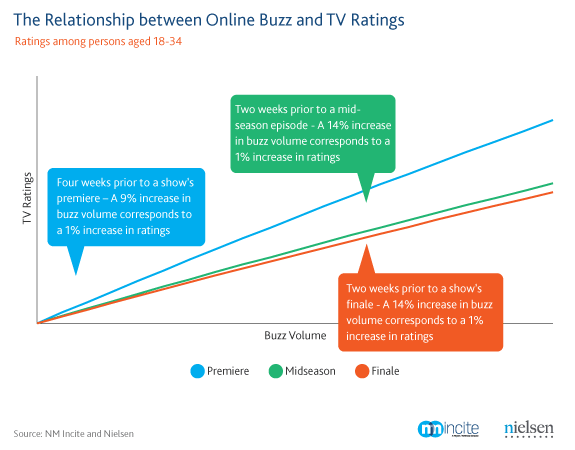Radha Subramanyam, SVP of Media Analytics
People aren’t just consuming content on social networks, they’re actively sharing it. As television becomes more digital – in the form of sharable video clips or articles about a show’s premiere, for example – social media will continue to play an increasingly important role in how consumers discover and engage with various forms of content, including TV.
An analysis conducted by NM Incite, a Nielsen/McKinsey Company, and Nielsen looked at the correlation between online buzz and television ratings and found a statistically significant relationship throughout a TV show’s season among all age groups, with the strongest correlation among younger demos (people ages 12-17 and 18-34), and a slightly stronger overall correlation for women compared to men. Men over 50 showed the weakest buzz-to-ratings connection leading up to a show’s premiere through the middle of the season, but that relationship strengthened by the finale as all age groups were actively discussing a TV show via social media.
Among people aged 18-34, the most active social networkers, social media buzz is most closely aligned with TV ratings for the premiere of a show. A few weeks prior to a show’s premiere, a nine percent increase in buzz volume correlates to a one percent increase in ratings among this group. As the middle of the season approaches and then the finale, the correlation is slightly weaker, but still significant, with a 14 percent increase in buzz corresponding to a one percent increase in ratings.
At the genre level, 18-34 year-old females showed significant buzz-to-ratings relationships for reality programs (competition and non-competition), comedies and dramas, while men of the same age saw strong correlations for competition realities and dramas.

Methodology
A model was created using 250 television programs and over 150 million social media sites to analyze the relationship between social media and television. Several buzz- and television-related inputs went into this model. Buzz metrics included buzz volume (the raw number of messages about a TV show), messages per source (as a proxy for spread of discussion) and the number of authors (total number of individuals generating the messages). Fundamental television factors included the genre of the show, whether the program aired on broadcast or cable, and the length of time the show had been on-air (first season, second, etc.). The amount of ad dollars spent promoting the show and prior ratings (both episode and season) were also considered.
These variables directly impact both ratings and buzz volume. They were included in the model to account for their contribution to understanding future TV ratings, and to bring clarity to the value that buzz provides.
For more on TV viewers getting social, download research and watch video from Nielsen’s Advertising Week presentations.



